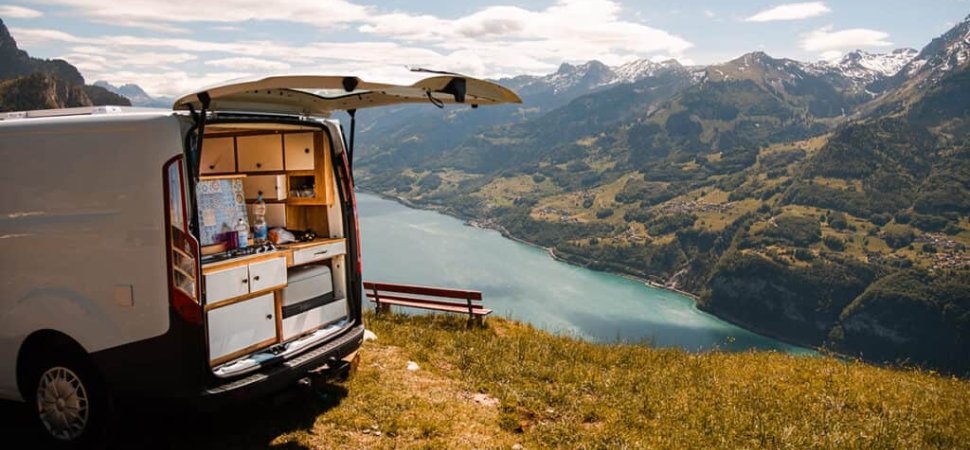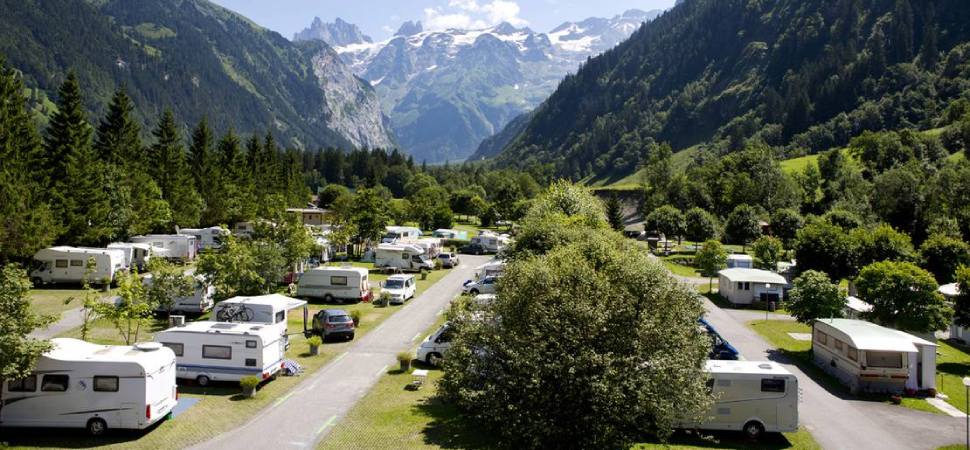Switzerland on wheels: A complete guide to places and routes for travelling
Route ideas for travelling around Switzerland in a motorhome
Giving up a night in a hotel and travelling to Switzerland by motorhome to sleep outdoors is a luxury you can now afford. Visiting the country on the move allows for a simple life far removed from everyday comforts and guarantees a change of scenery. From France, Germany, Italy or Austria, there are countless routes to visit the country. It all depends on whether you take a motorhome locally or rent one in your own country.
If you are short on time, we recommend limiting the area of your trip. You won't see everything, but you won't waste time on motorways and mountain roads. Here are some ideas of possible itineraries to visit Switzerland by motorhome, van or camper:
- 7 days: Geneva (old town, shores of Lake Geneva, St Peter's Cathedral, museums), Lausanne, Montreux, Vaux-Alpes (Les Diablerets, Gruyères-Pey d'Enchaux Regional Nature Park), Fribourg;
- 15-20 days: same itinerary, plus Neuchâtel & Lake, La Chaux-de-Fonds, Bern, Oberland Mountains, Interlaken, Jungfraujoch Glacier, Lucerne, Zurich, Rhine Falls, Basel;
- 1 month or more: same itinerary, plus Valais, Lugano, Lake Maggiore, Punta Terrarossa, Binn Valley Nature Park, Grisons, Lake Wallenstadt, Lake Constance.
How and where to rent a motorhome in Switzerland?
If you prefer to rent a motorhome directly on site, it is advisable to book online in advance to ensure that there will be cars available when you arrive.
To rent a motorhome, we recommend using an online camper or motorhome rental platform. There are a great number of such sites now on the market for caravanning and wild camping.
The principle is simple: you choose the vehicle you need - based on the daily price, type of motorhome/van/cabriolet and vehicle equipment - and send a rental request to the owner. The last step left: after paying online, you receive a confirmation email. You can then set off on your journey in Switzerland in peace!

Road traffic rules you need to know
1. Rules on the road
It's very simple here! Driving is on the right, overtaking is on the left, and the roads are generally in very good condition, even in the mountains. The road network is very well branched, even in the hollows of valleys, on passes and at higher elevations. In the city, remember that pedestrians have priority: always give way to people waiting on the pavement or already on the road, as fines (odd) will soon follow. Therefore, reduce your speed at every pedestrian crossing.
In the mountains, be especially careful as the roads can be narrow and winding. Rule of thumb: if the road does not allow two cars to separate, the one in front has priority unless there is room to turn before the crossing. However, a motorhome or converted van always has priority over a passenger car, even if travelling uphill. Be aware of the following speed limits:
- 50 km/h in populated areas;
- 80 km/h outside populated areas;
- 100 km/h on motorways;
- 120 km/h on motorways.
For vehicles weighing more than 3.5 tonnes, the speed limit on motorways is 100 km/h.
2. safety and equipment
You will need a driving licence, a road permit, a warning triangle and an anti-pollution certificate (for non-OBD vehicles, the equivalent of a roadworthiness test). The vehicle must also be equipped with a reflective waistcoat, first aid kit and spare bulbs.
3. Road signs
Road signs are posted in the language spoken in the locality visited (French, German, Italian or Romansh). Unlike in France, green signs are used for motorways and blue signs are used for secondary roads. Note that the Swiss road code requires all drivers to switch on their dipped headlights, even during daylight hours.
Motorway tolls in Switzerland
There are no motorway tolls in Switzerland. Do you think this is good news? Not really. A vignette is required to use the Swiss motorway network. If you want to visit Switzerland in a van or minibus, you'll have to pay 40 Swiss francs (euro 36.50) for vehicles weighing less than 3.5 tonnes. For heavier vehicles, the fee is based on the total weight of the vehicle. The validity is for the whole year, from 1 January to 31 December of the following year (i.e. 14 months).
The vignette allows you to drive on all motorways in one purchase and it is naturally easier than a toll. The vignette can be purchased at the border in euros, as well as at post offices, petrol stations, garage workshops, TCS branches and traffic offices. About twenty motorways require the vignette to be attached to the windscreen.

Motorhome parks in Switzerland: Where to park?
There are more than 400 campsites in Switzerland in various price ranges. For the rest, we suggest using the park4night app. This tool is an invaluable assistant for those who want to visit the country in a motorhome or converted van. It's a platform for travellers to share their favourite places, pointing out nature spots, free or paid parking, motorhome parks and campsites. If you love travelling, it can save you hours of searching for a place to stay every day!
When is the best time to travel by motorhome in Switzerland?
Due to the variety of climatic conditions and influences, Switzerland's mountains experience a wide range of temperatures due to nightly variations. At higher altitudes, winter can be very harsh, but you can still ski in the Alps (don't forget chains and snow tyres). Autumn and spring can be cold and rainy.
The best time to visit Switzerland in a motorhome, van or camper is summer, from June to September. However, even in summer, if you are travelling to the Alps, the nights can be chilly. Summer is also the busiest time for tourists: prices, already high in Switzerland, rise with the summer tourist season.
Conclusion
Travelling around Switzerland in a motorhome is a great way to see the country at its best: mountainous landscapes, cosy towns and natural parks. The ability to plan your route and stop at places that appeal makes this format of travelling unforgettable. You set the rhythm of the trip yourself, allowing you to maximise your enjoyment of Switzerland's beauty. Whether you choose a short itinerary or a long journey, this format opens up freedom and new experiences.



Comments
Post a Comment